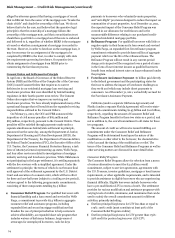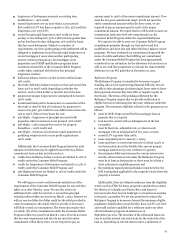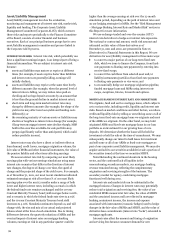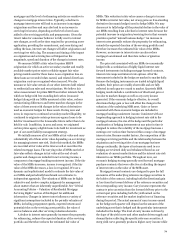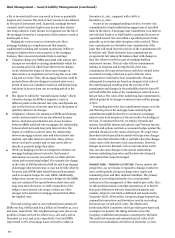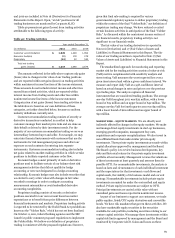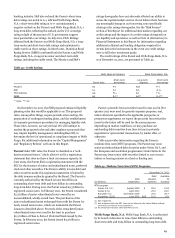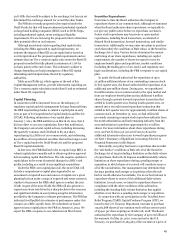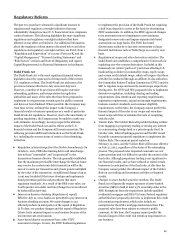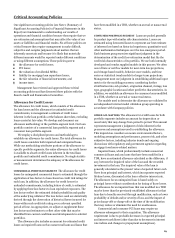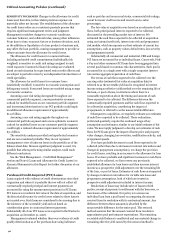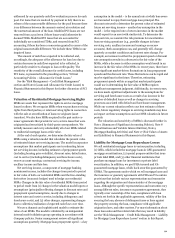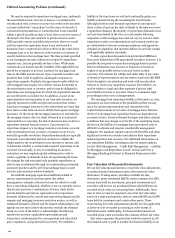Wells Fargo 2011 Annual Report Download - page 84
Download and view the complete annual report
Please find page 84 of the 2011 Wells Fargo annual report below. You can navigate through the pages in the report by either clicking on the pages listed below, or by using the keyword search tool below to find specific information within the annual report.
Risk Management – Asset/Liability Management (continued)
securities are recognized in net income when realized and
periodically include OTTI charges.
Changes in equity market prices may also indirectly affect
our net income by affecting (1) the value of third party assets
under management and, hence, fee income, (2) particular
borrowers, whose ability to repay principal and/or interest may
be affected by the stock market, or (3) brokerage activity,
related commission income and other business activities. Each
business line monitors and manages these indirect risks.
Table 41 provides information regarding our marketable
and nonmarketable equity investments.
Table 41: Nonmarketable and Marketable Equity Investments
December 31,
(in millions)
2011
2010
Nonmarketable equity investments:
Private equity investments:
Cost method
$
3,444
3,240
LIHTC investments - equity method (1)
4,077
3,611
All other equity method
4,434
4,013
Federal bank stock
4,617
5,254
Principal investments
236
305
Total nonmarketable
equity investments (2)
$
16,808
16,423
Marketable equity securities:
Cost
$
2,929
4,258
Net unrealized gains
488
931
Total marketable
equity securities (3)
$
3,417
5,189
(1)
Represents low income housing tax credit investments
(2)
Included in other assets on the balance sheet. See Note 7 (Premises, Equipment,
Lease Commitments and Other Assets) to Financial Statements in this Report for
additional information.
(3)
Included in securities available for sale. See Note 5 (Securities Available for Sale)
to Financial Statements in this Report for additional information.
LIQUIDITY AND FUNDING
The objective of effective liquidity
management is to ensure that we can meet customer loan
requests, customer deposit maturities/withdrawals and other
cash commitments efficiently under both normal operating
conditions and under unpredictable circumstances of industry
or market stress. To achieve this objective, the Corporate ALCO
establishes and monitors liquidity guidelines that require
sufficient asset-based liquidity to cover potential funding
requirements and to avoid over-dependence on volatile, less
reliable funding markets. We set these guidelines for both the
consolidated balance sheet and for the Parent to ensure that
the Parent is a source of strength for its regulated, deposit-
taking banking subsidiaries.
Unencumbered debt and equity securities in the securities
available-for-sale portfolio provide asset liquidity, in addition
to the immediately liquid resources of cash and due from banks
and federal funds sold, securities purchased under resale
agreements and other short-term investments. The weighted-
average expected remaining maturity of the debt securities
within this portfolio was 4.9 years at December 31, 2011. Of the
$212.6 billion (cost basis) of debt securities in this portfolio at
December 31, 2011, $38.5 billion (18%) is expected to mature
or be prepaid in 2012 and an additional $34.8 billion (16%) in
2013. Asset liquidity is further enhanced by our ability to sell or
securitize loans in secondary markets and to pledge loans to
access secured borrowing facilities through the Federal Home
Loan Banks (FHLB) and the FRB. In 2011, we sold or
securitized mortgage loans of $353 billion. The amount of
mortgage loans and other consumer loans available to be sold,
securitized or pledged was approximately $222 billion at
December 31, 2011.
Core customer deposits have historically provided a sizeable
source of relatively stable and low-cost funds. At December
31, 2011, core deposits funded 113% of total loans compared
with 105% a year ago. Additional funding is provided by long-
term debt (including trust preferred securities), other foreign
deposits, and short-term borrowings. Long-term debt averaged
$141.1 billion in 2011 and $185.4 billion in 2010. Short-term
borrowings averaged $51.8 billion in 2011 and $46.8 billion in
2010.
We anticipate making capital expenditures of
approximately $930 million in 2012 for our stores, relocation
and remodeling of our facilities, and routine replacement of
furniture, equipment and servers. We fund expenditures from
various sources, including funds from operations and
borrowings.
In mid-2009, we froze the Wells Fargo & Company Cash
Balance Plan. As a result, pension funding is not a material
consideration in our liquidity management. See Note 20
(Employee Benefits and Other Expenses) to Financial
Statements in this Report for additional information on
pension and postretirement plans.
We access domestic and international capital markets for
long-term funding through issuances of registered debt
securities, private placements and asset-backed secured
funding. Investors in the long-term capital markets generally
will consider, among other factors, a company’s debt rating in
making investment decisions. Rating agencies base their
ratings on many quantitative and qualitative factors, including
capital adequacy, liquidity, asset quality, business mix, the level
and quality of earnings, and rating agency assumptions
regarding the probability and extent of Federal financial
assistance or support for certain large financial institutions.
Adverse changes in these factors could result in a reduction of
our credit rating; however, a reduction in credit rating would
not cause us to violate any of our debt covenants.
In September 2011, Moody’s Investors Service, Inc.
(Moody’s) downgraded the long-term senior debt ratings of the
Parent and Wells Fargo Bank, N.A., the Parent’s significant
banking subsidiary, one notch to A2 and Aa3, respectively,
based on its determination that, as a result of the Dodd-Frank
Act, the U.S. government is less likely to support systemically
important financial institutions, if needed, in the future.
Moody’s outlook on the Parent’s and Wells Fargo Bank, N.A.’s
long-term senior debt ratings is negative based on the
possibility that Moody’s may further reduce its assumptions
about the likelihood of government support for systemically
important financial institutions. In November 2011, S&P
lowered the long-term senior debt ratings of the Parent and
Wells Fargo Bank, N.A. one notch to A+ and AA-, respectively,
following changes in S&P’s ratings criteria for the global
82




